#Aboriginal & Pacific Art Gallery
Explore tagged Tumblr posts
Text
Australia's top nine historical and cultural museums

Australia's historical and cultural museums offer captivating glimpses into the rich tapestry of the nation's past. These institutions serve as repositories of stories, artifacts, and memories that weave together the diverse threads of Australia's heritage. From the ancient Aboriginal cultures that have thrived on this land for thousands of years to the more recent chapters of European settlement and immigration, these museums chronicle the journey of a nation. Stepping into these museums is like embarking on a journey through time, where visitors can explore the experiences of Australia's indigenous peoples, learn about the trials and triumphs of early settlers, and witness the cultural fusion that has resulted from waves of immigration over the centuries. Whether it's the rugged landscapes of the outback, the bustling streets of colonial cities, or the vibrant multicultural communities of modern-day Australia, these museums provide windows into the many layers of Australian identity. Through carefully curated exhibits, interactive displays, and immersive experiences, visitors can gain a deeper understanding of Australia's history, culture, and traditions. From the iconic Sydney Opera House to the remote reaches of the Northern Territory, each museum offers a unique perspective on the Australian story, inviting visitors to explore, learn, and connect with the past in meaningful ways. Whether you're a curious traveller or a lifelong resident, Australia's historical and cultural museums hold treasures waiting to be discovered.
Here are some of Australia's historical and cultural museums.
1. Australian Museum, Sydney: The Australian Museum, located in Sydney, is Australia's oldest museum, having opened in 1827. It has a vast collection of natural history objects, including fossils, minerals, and indigenous artifacts. Visitors may explore displays on Australian wildlife, Aboriginal culture, and Pacific Islander heritage, making it a must-see for anybody interested in the country's natural and cultural past.
2. National Museum of Australia, Canberra: The National Museum of Australia, located in Canberra, displays the country's social, cultural, and political history. Its eclectic displays include issues including Aboriginal and Torres Strait Islander heritage, immigration, and national identity. The museum's interactive displays and immersive experiences provide visitors with unique insights into Australia's past and present.
3. The Australian War Memorial (in Canberra): The Australian War Memorial, also in Canberra, commemorates the sacrifices of Australians who fought in wars and conflicts. It houses a museum with large collections of military items, including weaponry, uniforms, and personal belongings. The memorial's commemoration areas, such as the Hall of Memory and the Roll of Honor, pay solemn respect to the nation's dead troops.
4. Powerhouse Museum, Sydney: The Powerhouse Museum, a division of the Museum of Applied Arts and Sciences, is a premier institution displaying science, technology, design, and social history. The museum, located in Sydney, hosts interactive displays on subjects ranging from space exploration to fashion and transportation. Its unique collection attracts visitors of all ages, making it a popular location for both families and aficionados.
5.The National Gallery of Victoria (in Melbourne) : The National Gallery of Victoria (NGV) is Australia's oldest and most popular art museum, situated in Melbourne. It has an extensive collection of artworks from diverse periods and genres, including Australian indigenous art, European masterpieces, and modern works. The NGV organizes temporary exhibits, public activities, and educational projects, making it a vibrant cultural destination for both locals and visitors.
6.The State Library of New South Wales in Sydney The State Library of New South Wales, located in Sydney, is one of Australia's major libraries, hosting an extensive collection of historical and cultural items. Its collections include rare books, manuscripts, pictures, and maps that shed light on the state's history and legacy. The library provides exhibitions, events, and research services and welcomes people to explore its treasures and use its resources.
7.Old Melbourne Gaol (in Melbourne): The Old Melbourne Gaol is a historic landmark and museum in Melbourne that depicts Australia's convict heritage. Built in the nineteenth century, the prison housed legendary convicts such as bushranger Ned Kelly. Visitors may go through the gaol's cells, gallows, and displays on crime and punishment, immersing themselves in the harsh reality of colonial justice.
8.National Portrait Gallery, Canberra: The National Portrait Gallery in Canberra showcases Australia's rich cultural heritage through portraiture. Portraits of notable personalities from Australian history, such as politicians, artists, athletes, and indigenous leaders, are included in the collection. The gallery's exhibitions and events examine issues like identity, representation, and narrative, providing visitors with a better knowledge of the individuals who have built the nation.
9.Western Australian Maritime Museum, Fremantle: The Western Australian Naval Museum, located in Fremantle, celebrates the state's nautical heritage and seagoing history. Its displays focus on shipwrecks, exploration, and naval warfare, with highlights including the America's Cup-winning yacht Australia II and the Oberon-class submarine HMAS Ovens. The museum's waterfront setting and interactive displays attract both maritime aficionados and families.
Conclusion
Australia's historical and cultural museums are not just repositories of artifacts but gateways to understanding the essence of the nation. They offer a glimpse into Australia's rich tapestry of history, culture, and identity, allowing visitors to connect with the past in profound ways. Whether you're exploring the ancient traditions of indigenous peoples or delving into the stories of immigrants who have shaped the country, these museums provide valuable insights into what it means to be Australian. For travelers planning to visit these museums and explore Australia's wonders, obtaining an Australia visa from Delhi is an essential step. With an Australia Tourist Visa from Delhi, visitors can embark on a journey of discovery, immersing themselves in the vibrant cultural landscape of the country. From the bustling streets of Sydney to the serene beauty of the Great Barrier Reef, there's no shortage of experiences awaiting those who venture down under. So, whether you're drawn to the iconic landmarks of the cities or the natural wonders of the outback, Australia's museums stand ready to enrich your understanding of this fascinating country. With their wealth of exhibits, interactive displays, and immersive experiences, these institutions offer something for everyone, making them essential stops on any Australian adventure.
#Australia Visa from Delhi#Australia Visit Visa from Delhi#Australia Tourist Visa from Delhi#Australia visit visa processing time from Delhi#Australia Tourist visa cost from Delhi#Australia Tourist visa price from Delhi#Australia Visa appointment in Delhi
0 notes
Text




#Canadian #ArtHerstory Emily Carr (Dec 13, 1871 – Mar 2, 1945) was a Canadian artist and writer who was inspired by the Indigenous peoples of the Pacific Northwest Coast.
One of the painters in Canada to adopt a Modernist and Post-Impressionist style, Carr did not receive widespread recognition for her work until she changed her subject matter from Aboriginal themes to landscapes — forest scenes in particular, evoking primeval grandeur.
As a writer Carr was one of the earliest chroniclers of life in British Columbia. The Canadian Encyclopedia describes her as a "Canadian icon".
1. “War Canoes, Alert Bay”, Emily Carr, 1912, oil on canvas.
2. #EmilyCarr in her studio, in front of "Sunshine and Tumult", c. 1939. photo by Harold Mortimer-Lamb. Visual Resources Collection, Library and Archives, National Gallery of Canada, Ottawa.
3. Emily Carr's 1931 seaside forest scene, "Cordova Drift," is seen in an undated handout image. The mature-era canvas hammered down for nearly $3.4 million at a digital auction on Wednesday evening. THE CANADIAN PRESS/HO-Heffel Fine Art Auction House, Ward Bastian
via www.timescolonist.com/entertainment/emily-carr-painting-sells-for-3361-million-at-auction-4826132 (2021)
#womensart #PalianShow #ArtbyWomen #GreatWomenPainters
0 notes
Text
Unravel the Beauty of Australia: Exclusive Tour Packages Available
Are you ready to embark on an unforgettable journey to explore the breathtaking landscapes and unique wonders of Australia? Look no further as we unveil an array of exclusive Australia tour package that promise to deliver an extraordinary adventure like no other. From the iconic landmarks of Sydney to the untamed wilderness of the Outback, Australia offers an enchanting blend of natural beauty, cultural diversity, and thrilling experiences. Join us as we delve into the mesmerizing highlights of our Australia tour packages and discover the secrets of this captivating continent.

Australia Tour Packages: The Gateway to Adventure
Our carefully curated Australia tour packages are designed to cater to every traveler's dream, whether you seek thrilling escapades, cultural immersions, or serene getaways. With a range of customizable itineraries, you can tailor your journey to suit your preferences and desires. From the sun-kissed beaches of the Gold Coast to the lush rainforests of Queensland, our tours promise an exploration of Australia's diverse landscapes and hidden gems. Travel with us, and each day will unfold new adventures, unforgettable memories, and friendships to last a lifetime.
Sydney Splendors: Unmissable Gems
Kickstart your Australia tour package with a visit to the enchanting city of Sydney. Admire the architectural marvel that is the Sydney Opera House, standing proudly against the backdrop of the stunning Sydney Harbour Bridge. Stroll along the famous Bondi Beach, where golden sands meet the azure waters of the Pacific Ocean. Experience the vibrant energy of the city's bustling markets and indulge in delectable cuisines at the trendy waterfront restaurants. Sydney offers a perfect blend of cosmopolitan living and natural beauty that will leave you in awe.
The Mystique of the Great Barrier Reef
No Australia tour package is complete without exploring the wonders of the Great Barrier Reef. Dive into the mesmerizing world of vibrant corals, exotic marine life, and crystal-clear waters. Snorkeling or scuba diving in this natural wonder will be an unforgettable experience, as you come face-to-face with the underwater wonders that make the Great Barrier Reef a UNESCO World Heritage Site. Whether you're an experienced diver or a first-timer, the reef's splendor will leave you breathless.
Exploring the Australian Outback: A Journey into the Wild
Venture into the heart of Australia's rugged landscapes with our Outback expedition. Explore the vast stretches of red deserts, ancient rock formations, and mystical Aboriginal sites. Witness the magical Uluru at sunrise or sunset, as it casts a mesmerizing glow over the desert. Experience the unique lifestyle of the Outback locals and savor traditional bush tucker around a campfire under the starlit sky. This leg of your Australia tour package promises an authentic encounter with the raw beauty of the land Down Under.
Melbourne: Where Culture Meets Creativity
Dive into the artistic and cultural hub of Australia as you explore the dynamic city of Melbourne. This vibrant metropolis boasts a diverse arts scene, lively street art, and a thriving coffee culture. Wander through the charming lanes and arcades, discovering boutique shops, art galleries, and hidden gems. Don't miss a trip to the Yarra Valley, where you can indulge in some of Australia's finest wines amidst picturesque vineyards. Melbourne is a city that captures the essence of creativity and sophistication.
Australia beckons with its allure of stunning landscapes, unique wildlife, and rich cultural tapestry. Our exclusive Australia tour packages are meticulously crafted to showcase the best of this enchanting continent. Whether you wish to explore the iconic landmarks, dive into the underwater wonders, venture into the Outback, or immerse yourself in the cultural richness, Australia has something extraordinary to offer. Unravel the beauty of Australia with us, and let this be the journey of a lifetime - a journey etched in your heart forever. So, pack your bags, set your soul free, and get ready to embark on an adventure like no other!
Must Read : Embark on an Adventure of a Lifetime with our Australia Tour Packages
0 notes
Link
0 notes
Text

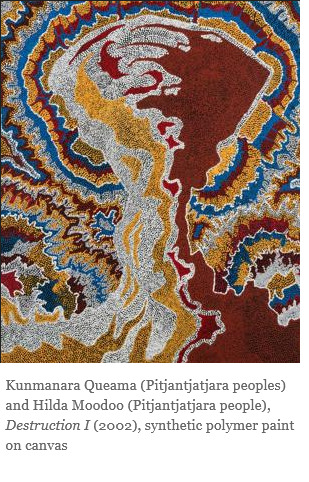
At 6.9 feet in height and 6.2 feet in diameter, Ainu artist Kohei Fujito’s iron sculpture, The Singing of the Needle (2021), is an imposing size, with an iron screen bristling with rough spirals barbed with spikes. A painted deer skull is mounted on a pole at its center, surrounded on all sides by the iron screen like it’s being shielded, from some external threat. In 2011, in the wake of the Fukushima Daiichi nuclear disaster in Japan, Fujito was concerned about the effect of radioactive winds on his Ainu family and community on Hokkaido, Japan’s northernmost prefecture.
“The spiral pattern throughout the work is based on a traditional Ainu symbol for wind,” says Manuela Well-Off-Man, chief curator at the Institute of American Indian Arts’ Museum of Contemporary Native Arts. [...]
Exposure: Native Art and Political Ecology is the first large-scale international exhibition of Indigenous artists responses to nuclear disaster and proliferation. It includes about 45 works by more than 30 Indigenous artists from the United States, Canada, Greenland, Japan, Australia, and the Pacific Islands.
The regions represented in the exhibition, which opens at IAIA MoCNA on Friday, Aug. 20 [2021], are united by similar narratives. Perhaps no toll visited on Earth by the deleterious effects of radiation is greater than that on its Indigenous communities.

Much of the nuclear testing and related disasters happened decades ago, often without public knowledge, and impacted communities who had insufficient understanding of the long-term effects. In the United States, the ramifications of widespread uranium extraction on tribal lands continues to this day. According to the Environmental Protection Agency, 75 percent of the nation’s 15,000 abandoned uranium mines are on Federal tribal land, including more than 1,000 on the Navajo Nation.

Diné photographer Will Wilson addresses the subject in his drone-based photographic triptych Mexican Hat Disposal Cell, Navajo Nation (2020-2021), which shows aerial views of contaminated uranium mines and mills, and in two images on display from his Autoimmune Response (AIR) series (circa 2005). The latter is an Indigenous futurist look at a post-apocalyptic world that situates its subject (Wilson donning a gas mask) in the majestic but toxic landscape of the Navajo Nation, which has a history of devastation caused by uranium, oil, and gas extraction.
Destruction I (2002) is located at the entrance of the Anne and Loren Kieve Gallery, where the main part of the exhibition is housed. It’s a 4-foot by 3-foot painting by Aboriginal artists Kunmanara Queama and Hilda Moodoo (both Pitjantjatjara people) that depicts a multicolored atomic mushroom cloud, rendered as a traditional Aboriginal dot painting.
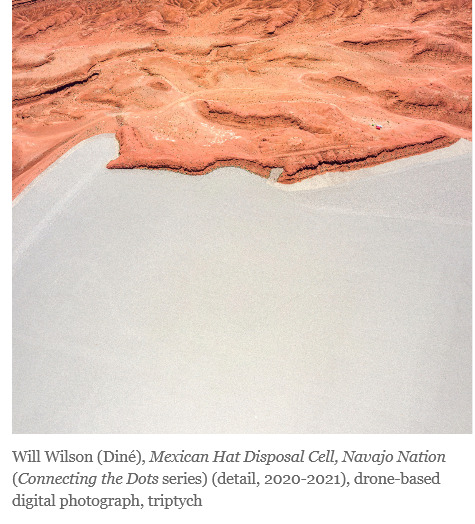
“What we’re doing with this exhibition is giving international Indigenous artists a voice to comment on the impact of nuclear exposure, like here in New Mexico, from the first atomic bomb development and tests but also from uranium mines,” Well-Off-Man says. “Similarly, in Australia, there were atomic bomb tests throughout the 1950s and ‘60s. Like here, with our uranium mines, these tests were conducted on Aboriginal land, without consulting with tribal governments and tribal elders. The government tried to move entire communities, but they didn’t really explain what would happen, and some of the Aboriginal tribal members stayed on the land. They never got the message, and they got severely sick or died of cancer.” [...]
A visual motif in the form of biohazard and radiation symbols runs through the exhibition. Samoan artist Dan Taulapapa McMullin’s Radiation Mats (2021) are intended as markers, alerting the viewer that the separate spaces are part of the same show. They also reflect the exhibition’s theme. The symbols are superimposed over photographic imagery of landscapes and people of the Bikini Atoll, whose inhabitants were forcibly removed in 1946 in advance of a series of nuclear tests conducted by the United States the following decade. When the inhabitants were allowed to return, more than two decades later, they were poisoned by high concentrations of the radioactive isotope Caesium-137 and high levels of Strontium-90 in the well water, prompting mass evacuations in 1980 [...]
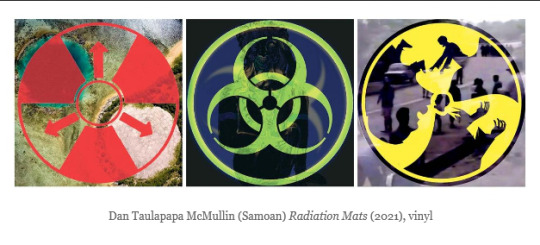
Other works by McMullin include Clouds (2021), a video installation that places the history of nuclear testing in American Micronesia and French Polynesia into a contemporary context, and Te Mau Ata: Clouds (2021), a photo-collage depicting Bikini’s displaced people and French Polynesia’s anti-nuclear and independence activists amid the eponymous mushroom clouds created by nuclear blasts.
It’s significant that Exposure, which travels next year, launches in New Mexico, where the first atomic bomb test was conducted. That event was a precursor to the first deliberate use of a nuclear weapon (on the Japanese cities of Hiroshima and Nagasaki on Aug. 6 and 9, 1945) mere weeks after the historic test at Trinity Site, New Mexico, on July 16. [...]
Well-Off-Man organized the exhibition in collaboration with guest curators from around the world, including iBiennale Director Kóan Jeff Baysa, Hokkaido Museum of Modern Art Chief Curator and Vice Director Satomi Igarashi, and independent curator Tania Willard (Secwepemc Nation).
-------
Headline, images, captions, and all text published by: Michael Abatemarco. “Invisible invader: Indigenous artists respond to the nuclear legacy.” Santa Fe New Mexican. 20 August 2021.
3K notes
·
View notes
Text
Look At All Those Chickens (And Sheep)
On Monday morning we drove to the Waitangi Treaty Grounds to learn more about New Zealand’s history and the relationship between the aboriginal Māori and the European settlers. The story here is similar to most places where Europeans settled; however, it’s different in the way that Kiwis make a real effort to recognize Māori culture, language, and traditions.
We learned that the Treaty of Waitangi was signed in 1840 to institute British governance in NZ and establish peace and order. The document was intentionally mistranslated so that while the Māori believed they were just giving the British the right to govern them, the English version said that they were giving up their sovereignty. This treaty has been highly debated since its signing. The story that struck me the most was about Lord Bledisloe, a former governor general of NZ. In 1932, he purchased over 1,000 acres of land surrounding the treaty grounds and gave all of it back to the people, even though it’s prime real estate with a scenic view of the Bay of Islands. We need more government officials like him ASAP.

After finishing walking the grounds, we grabbed lunch to-go at a local fish and chips joint before heading to Waitangi Falls. There was a picnic bench in the parking lot for the waterfall so we decided to eat there. Wrong choice. We were immediately swarmed by chickens. They kept flying up on the table staring at us as we kept shooing them away. This resulted in us scarfing down our food before walking over to the falls where we were able to sit peacefully on top of the waterfall and meditate to the sound of the rushing water.

Once we felt relaxed, we drove a few hours to Ahipara where we checked into our YHA hostel. The hostel was composed of a collection of little cabins surrounded by beautiful flowers and foliage. We were only a few minutes walk to 90 Mile Beach, so we went for a little stroll before dinner. The tide was low and the water was surprisingly warm. We were even lucky enough to find a few abalone (pāua) shells sticking out of the sand on our way off of the beach.

Back at the hostel, we cooked up a big meal of pesto pasta with veggies and ate our dinner outside with a glass of wine. There was a TV with movies in the common area so Mary and I relaxed after dinner with a viewing of “Three Billboards Outside Ebbing, Missouri”.

The next day we made the hour and 45 minute trip up to Cape Reinga which is the northwestern most tip of the North Island. Our intent was to stop along the way at whatever attractions we noticed. That didn’t work out so well as there’s pretty much nothing to see between Ahipara and Cape Reinga. When we arrived, we walked down to the lighthouse, reading signs about the cape the whole way down. We learned that the cape is a sacred place for the Māori people as it is thought to be the point in which spirits jump off and begin their journey into the afterlife. From the cape, we were also able to see where the Tasman Sea meets the Pacific Ocean. The clash of the different bodies of water is evident from the constant white water and waves forming where they connect.

We ate our lunches at a local camping spot just a 15 minute drive from the cape and then headed back to Ahipara. On the way back we did make one stop for Real Fruit Ice Cream, which we were forced to eat in the car due to rain. Once we were back, we went for a swim at 90 Mile Beach and meditated in the sand.
The next day, we packed up our things and took one last stroll along 90 Mile Beach before making our way to the Waipoua Forest. Along the route, we passed by a cute town called Hokianga. Since we weren’t on any tight timeframe, we stopped to explore. I grabbed a coffee and we meditated on a dock where we saw the occasional fish leaping out of the water. We also stopped in an interesting art gallery where we both bought some artwork and connected with the American store owner. About 5 minutes down the road we ended up getting on a car ferry where we ate our lunches with the windows cracked. Soon enough, we made it to the forest which is filled with kauri trees. We were able to do two walks to see the largest and second largest of these great trees.
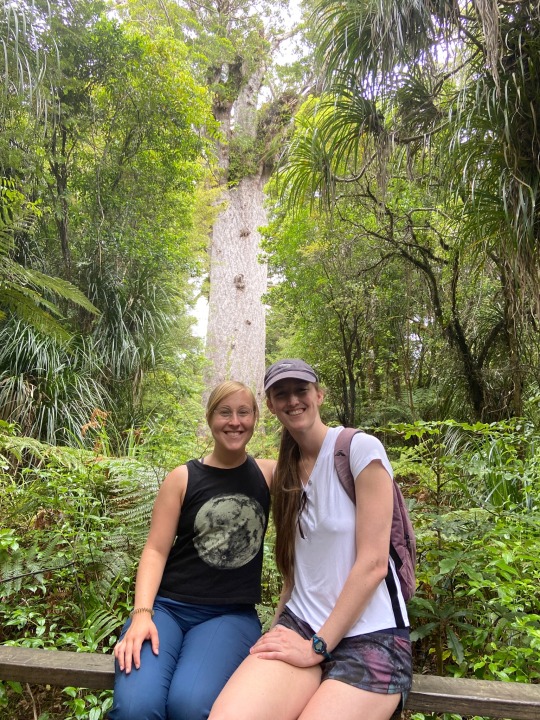
After enjoying the nature, we headed to our next Airbnb which was on a farm in Mamaranui. Upon arrival we were greeted by one of our hosts, Dennis, with a beer in hand. Mary and I relaxed until the other host, Julie, arrived to give us a farm tour. She showed us her two adorable babydoll lambs, collection of sheep, goats, and pigs, and let us participate in feeding them dinner. Next, she made us a tasty dinner of homemade pizza and garlic bread, topped off with complementary wine, which we enjoyed on the deck while watching the sunset over the farm.
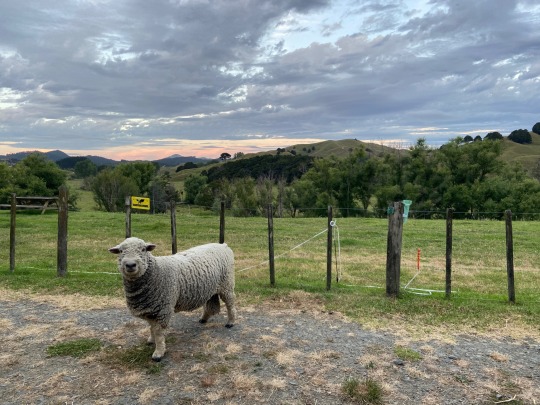

The next morning, we got to bottle-feed the lambs and have some good chats with Julie and Den. I could not have imagined a better place to end our trip. The next thing we knew, we were back in Auckland for Christmas Eve. Alecia hosted a party at our place and we had a bunch of our expat friends over to celebrate since they were unable to be with their own families. We threw some food on the grill and enjoyed a lively white elephant gift exchange. Alecia even got ornaments for everyone and let us take turns decorating the tree. It was a lovely way to celebrate the holiday.
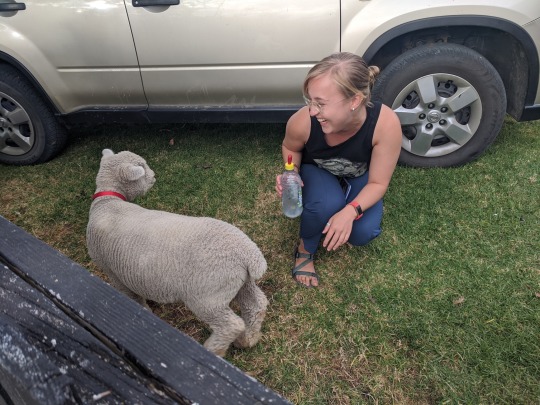
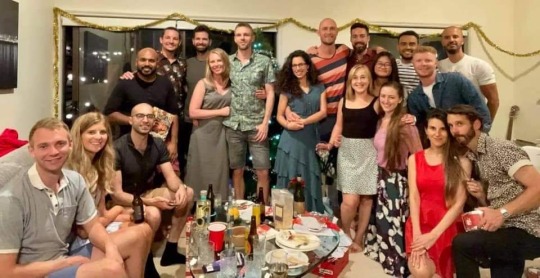
2 notes
·
View notes
Photo






Banksia
1 Margaret Preston Australian (1875-1963) Banksia (1938) oil on canvas 53.2x42.6cm
2 banksia cone in bud, Katoomba, NSW
3 banksia cone post flowering, Ulladulla, NSW photos: optikes
4 Margaret Preston Banksia (1932) woodcut 15.2x14.8cm
5 Margaret Preston West Australian Banksia (1929) woodcut, hand-coloured with gouache 44.2x38cm
6 Margaret Preston Self Portrait (1930) oil on canvas 61.3x51.1cm
commissioned by the Trustees of the Art Gallery of NSW
A artgallery.nsw.gov.au
'… my self-portrait is completed, but I am a flower painter – I am not a flower' MP
Using both painting and woodcut, she stylised domestic objects and native Australian flowers into dynamic, formally precise compositions....Preston travelled widely throughout the Pacific, Asia, India and Africa, where she cultivated an interest in non-European art and culture. Incorporating diverse styles and motifs into her work, she sought to create a visual language that engaged with Australia’s place in the Asia Pacific region and placed Aboriginal art in a foundational position.
-----------------------------------------------------------------------------------------------
Banksia is a member of the protea (Proteaceae) family and is a genus of around 75 species of evergreen shrubs and trees that feature attractive foliage, bold flowering spikes, and interesting fruiting cones. These woody low-growing shrubs to low-branching trees are endemic to Australia, with just one species, Banksia dentata, extending from northern Australia to New Guinea. The genus is named for Sir Joseph Banks, the renowned English botanist who first documented the plants on his travels around Australia with Captain Cook, and who was one of the founders of the Royal Horticultural Society.
Banksias vary from prostrate shrubs to low-branching trees. They are sturdy plants, often with a stout trunk. Typically they have long, leathery, coarsely toothed leaves, though a few species have finer or more needle-like foliage. Cylindrical or globular spikes are densely packed with hundreds of small flowers. The individual thread-like blooms are long lasting and nectar-rich. As the flowers die they develop into large, woody, fruiting cones. Flowering time varies, depending on the species.
Most species prefer an open sunny position and well-drained sandy soil low in phosphorus. Some banksias are moderately frost tolerant and once established, most will withstand dry conditions. Taking cut flowers will encourage flower production and thicken up the foliage. Propagate from seed, which often germinates better if heated or smoked. Some easy-to-cultivate species will also grow from half-hardened cuttings.
abc.net.au © Global Book Publishing (Australia) Pty Ltd from Flora's Gardening Cards
1 note
·
View note
Photo










Château Laurier, Ottawa (No. 2)
When the Grand Trunk became part of the Canadian National Railway in 1923, the Château Laurier became one of CN's most important hotels. In addition to hotel guests, the Château Laurier has also served over the years as the home of two important Ottawa institutions. From July 1924 to October 2004, the seventh and eight floors at the top were home to the Canadian Broadcasting Corporation's local English and French language radio stations. Photographer Yousuf Karsh maintained his studio and residence at the Château Laurier for many years.
In 1929, a $6-million east wing addition by Montreal architect John Archibald and CN's architect John Schofield along Mackenzie Avenue added 240 rooms. Although the exterior of the addition was French-inspired, the interior lobby resembled an English or Scottish baronial hall with dark-oak panelling, a railed gallery overlooking the double-height space and trophies of the hunt. The lobby led to a convention hall, music room and gentlemen's lounge. The ballroom featured vaulted ceiling, columns and rich drapes. The ultra-modern kitchen was designed to cater to up to 5,000 people. The Jasper Tea Room designed by Edwin Holgate in 1929, featured Pacific Coast aboriginal art, columns carved into totem poles surrounding a dance floor, and lamps decorated with motifs of bears, eagles and crows. From 1929–1991, the Canadian Grill was a softly-lit and dark-panelled below-ground restaurant where diners ate the specialty, roast prime rib of beef au jus and danced to live music.
In 1930, the hotel added a 60-foot indoor pool in Art Deco style. In the 1930s and 1940s, the "therapeutic" spas offered electric therapy, ultra-violet ray lamps and alternate streams of hot and cold water to clients with nervous afflictions, polio or back problems.
For years, the hotel thrived, playing host to royalty, heads of state, political figures, celebrities and members of Canada's elite. R. B. Bennett lived in a suite in the hotel during his term as Canadian prime minister, from 1930 to 1935.
During the 1960s and 1970s, the construction of numerous competing hotels in the capital, as well as the closure of Union Station, led to a slow decline in the Château's fortunes.
In 1965, the Jasper Lounge, was redecorated into a mock English tavern called the Cock and Lion with oak and old brick walls. The union went to court to protest management's decision to replace waiters with young women in low-cut tops to serve in the new pub, but lost.
In 1981, the hotel was designated a National Historic Site of Canada.[7] The Westin Hotel opened across the street in 1983. A $21-million renovation was undertaken in the 1980s to refurbish and renovate the Château Laurier, however, thus restoring its position as Ottawa's pre-eminent hotel. A new canopied front entrance was added. The lobby's dark wood was lightened and the animal trophies were removed. The barber shop was removed. The fourth floor featured a separate lounge and concierge desk. The smoke shop became the Reading Room. The Cock and Lion lounge was replaced a skylit boutique mall. In 1985, Zoe's Lounge opened in a new glassed-in area overlooking Rideau Street.
By 1991, Peacock Alley, which was broad corridor on the main level that extended along the west side of hotel was replaced by Wilfrid's, featuring views of the Parliament Buildings, the Rideau Canal locks and the Ottawa River.
The hotel was operated by Canadian National Hotels until the chain was purchased by Canadian Pacific Hotels in 1988.
In 1999, it was renamed the Fairmont Château Laurier after Canadian Pacific Hotels bought the American Fairmont hotel chain and changed its name to Fairmont Hotels and Resorts.
The new look was provided by Wilfrid's on the main level, its big windows giving light and views of the Parliament Buildings, the Rideau Canal locks and the Ottawa River.
The hotel is just metres away from some of the capital's most important landmarks including Parliament Hill, the Rideau Canal, the National Gallery of Canada, the Byward Market, the National War Memorial, the U.S. Embassy, and the CF Rideau Centre. Given its proximity to these buildings and the fact that it has served as a home and meeting place for many notable political figures over the years, the hotel has often been referred to as "the third chamber of Parliament".
The hotel was the inspiration for the "Hotel du Canada" at the Canada (Epcot) pavilion in Orlando, Florida. In 2000, the Royal Architectural Institute of Canada chose the building as one of the top 500 buildings produced in Canada during the last millennium.
Coinciding with its 100th anniversary, Fairmont Château Laurier was included amongst other architecturally interesting and historically significant buildings in Doors Open Ottawa, held June 2 and 3, 2012.
The hotel was purchased by Larco Investments in 2014, but continues to be managed by Fairmont. In September 2016, a major addition was proposed to create "long term stay" suites. The changes are pending approval from Ottawa city council.The design of the addition differs considerably from that of the original building, and has been met with criticism.
In 2018, the hotel was the setting of the dramatic web series Chateau Laurier. Due to budget constraints, however, the series was actually filmed at the Fairmont Royal York in Toronto.
Source: Wikipedia
#Château Laurier National Historic Site of Canada#Ottawa#Ontario#Canada#summer 2018#architecture#Gothic Revival Châteauesque#facade#detail#cityscape#Bradford Gilbert#Ross and Macfarlane#2015#Rideau Canal Locks#landmark#tourist attraction#vacation#travel#Rideau Canal#Rideau Canal National Historic Site
2 notes
·
View notes
Photo

4 MUSEUM, ARTS & CRAFTS TO VISIT ON BRUNY ISLAND Another top thing to do on Bruny Island by visiting the local museum to learn the history of Aboriginal people and the explorers. Some arts and crafts and local home-crafted ceramic which you can buy as a gift 🎁 📍NICKERS & CLAY | IG @nickersandclay Show and sell ceramic wares from cups, bowls and more. Address: Great Bay main Road Contact: 0428 606 255 📍LUMEAH GALLERY Selling unique handmade arts and woodcraft by locals. A great place to buy the locally made gift. Opening hours: vary Address: 120 Adventure Bay Contact: 0427 931471 📍THE BLIGH MUSEUM OF PACIFIC EXPLORATION Located on Adventure Bay road, the museum displays historic maps, books, documents, paintings and drawings and other artefacts relating to the landings at Adventure Bay by the famous Abel Tasman over James Cook and William Bligh as well as the French explorers and scientists D’Entrecasteaux, Flinders, Baudin and many more explorers. Worth to pay small admission. Opening hours: daily 10 am to 4 pm except Christmas day and Good Friday or by arrangement. Address: 876 Adventure Bay Rd, Adventure Bay TAS 7150, Australia Contact: 03 6293 1117 📍ZEGEL ART STUDIO BRUNY ISLAND Selling unique handmade arts and woodcraft by locals. A great place to buy the locally made gift. Opening hours: vary Address: 120 Adventure Bay Rd, Adventure Bay TAS 7150, Australia Contact: 0427 931471 Love this? Hit save so you can find this post again 🫶 #beautiful #crafty #handcrafted #artist #gifts #ceramics #crafts #art #australianceramicsopenstudios #handmade #tasmanianceramics #brunyisland #tasmania #travelgram #traveltheworld #travelphotography (at Hobart, Tasmania) https://www.instagram.com/p/CitfzaeP5cx/?igshid=NGJjMDIxMWI=
#beautiful#crafty#handcrafted#artist#gifts#ceramics#crafts#art#australianceramicsopenstudios#handmade#tasmanianceramics#brunyisland#tasmania#travelgram#traveltheworld#travelphotography
0 notes
Link
THE ULTIMATE DREAM PACKAGE
1 note
·
View note
Text
Top Three Historical Sites in Queanbeyan to Explore
Have you been mesmerized by the Australian culture and history? Want to explore more about it? And you have planned a tour to Queanbeyan, Canberra for exploring the hidden secrets of the country? Then to enjoy your tour in the town to the fullest, you need to make a stay for at least 2 to 3 days. So start looking for the best motels in Queanbeyan, Canberra like Hamilton's Queanbeyan Motel.

Let us take a look at some of the best sites that you can explore by making a stay at one of the best motels in Queanbeyan NSW:
The National Gallery of Australia
The National Gallery of Australia comprises objects from all over the world, that includes traditional and modern works from Asia and the Pacific, statues and paintings from European and American works along with indigenous, colonial and contemporary Australian art. It is the largest art museum in the country that is home to more than 160,000 works that include the all-embracing collection of Aboriginal art in the world.
As far as Asian collection is concerned, it comprises art from China, Japan, India, and beyond that include Hindu and Islamic sculptures from the Indian subcontinent as well as Buddhas and Neolithic artefacts from Southeast Asia.
The East and Central Asian galleries feature traditional wood prints and ceramic works.
The Pacific section includes a wide selection of sculptures and items from Melanesia and Polynesia.
European and American collection includes works by Picasso and Monet, pop art by Roy Lichtenstein and Andy Warhol, dada and surreal paintings, and modern works from both continents.
The Australian section holds an alarming selection of early colonial paintings, Australian Impressionist works, modern and abstract paintings, decorative arts and contemporary pieces in a range of media.
Australian War Memorial
The Australian War Memorial is one of the best monuments where the country pays its respects to members of the military killed in conflicts around the world. Completed in 1941, the Australian War Memorial is built dedicated to servicemen and women from the colonial era to today. There is a museum within the memorial complex that exhibits exploring the military history of Australia. This Byzantine-style memorial building is in a straight line of sight with the entry of Parliament House. There is the Hall of Memory where you can see the Tomb of the Unknown Soldier, the ANZAC Hall featuring military hardware, written accounts from soldiers and their partners, and stories about the battles fought and much more.
The Parliament House
The Parliament House, located in the centre of the city is the most prominent structure in the capital with incredible 62 acres of floor space. This building was envisioned and created by New York-based architectural firm Mitchell and Giurgola. The construction began in the year 1981 and officially opened in 1988 by Queen Elizabeth II. You can see a 246-ton (220-tonne) flagpole flying a 21 by 42-foot (6.4 by 12.8-meter) Australian flag, enjoy views of Lake Burley Griffin and the greater Canberra area, a tapestry based on a painting by Australian artist Arthur Boyd at the Great Hall and much more.
So make a stay at one of the best motels in Queanbeyan, Canberra and explore these amazing structures along with many other important sites.
Conclusion:
Hamilton's Queanbeyan Motel provides the most comfortable and convenient stay in the town allowing you to explore the best of Queanbeyan in a hassle-free way. Visit https://www.hamiltonsmotel.com.au/ for more information.
0 notes
Text
Sydney Opera House Projection, NSW
Opera House Projection, Sydney Building, SANAA Architects, Contemporary Art Installation, Photos
Opera House Projection in Sydney
23 Apr 2021
Sydney Opera House Projection
Architects: SANAA
Aboriginal artist Kaylene Whiskey celebrates Art Gallery of New South Wales’ 150th Anniversary with ‘Dolly visits Indulkana’ projection on the sails of Sydney Opera House as part of ‘Badu Gili: Wonder Women.’ Art Gallery of New South Wales celebrates 150th Anniversary with ‘Badu Gili: Wonder Women’ featuring work of six female Aboriginal artists projected onto the sails of Sydney Opera House. © the artist. Photo credit: Daniel Boud. Courtesy Art Gallery of New South Wales and Sydney Opera House
150th Anniversary Programme Will Culminate with the Completion of the Art Gallery’s Sydney Modern Project Expansion, Designed by SANAA, in 2022
Aboriginal artist Marlene Gilson celebrates Art Gallery of New South Wales’ 150th Anniversary with ‘Ballarat, my Country’ projection on the sails of Sydney Opera House as part of ‘Badu Gili: Wonder Women.’ Art Gallery of New South Wales celebrates 150th Anniversary with ‘Badu Gili: Wonder Women’ featuring work of six female Aboriginal artists projected onto the sails of SydneyOpera House. © the artist. Photo credit: Daniel Boud. Courtesy Art Gallery
First Event Features Collaboration with Sydney Opera House, Works by Six Aboriginal Women Artists Projected onto Sails as Part of Annual Badu Gili Festival of First Nations Culture
Aboriginal artist Judith Inkamala celebrates Art Gallery of New South Wales’ 150th Anniversary with ‘Ura kngarra mpintjama (A big fire is coming)’ projection on the sails of Sydney Opera House as part of ‘Badu Gili: Wonder Women.’ Art Gallery of New South Wales celebrates 150th Anniversary with ‘Badu Gili: Wonder Women’ featuring work of six female Aboriginal artists projected onto the sails of Sydney Opera House. Photo credit: Brook Mitchell/Getty Images for Art Gallery of NSW © the artist. Photo credit: Daniel Boud. Courtesy Art Galler
The Art Gallery of New South Wales today kicked off its 150th anniversary celebrations with a burst of colour and light, collaborating for the first time with the Sydney Opera House to mark the annual Badu Gili festival of First Nations Culture by projecting artworks onto the iconic sails of the Opera House.
The work of six leading Aboriginal women artists represented in the Art Gallery’s permanent collection will light up each evening in a six-minute animation on the sails, as the Gallery leads up to the completion in 2022 of its Sydney Modern expansion project, designed by SANAA.
Aboriginal artist Marlene Rubuntja celebrates Art Gallery of New South Wales’ 150th Anniversary with ‘Woman with dilly bags and dilly bag hat’ projection on the sails of Sydney Opera House as part of ‘Badu Gili: Wonder Women.’ Art Gallery of New South Wales celebrates 150th Anniversary with ‘Badu Gili: Wonder Women’ featuring work of six female Aboriginal artists projected onto the sails of Sydney Opera House. © the artist. Photo credit: Daniel Boud. Courtesy Art Gallery of New South Wales and Sydney Opera House
Michael Brand, Director, Art Gallery of New South Wales, said, “Badu Gili: Wonder Women celebrates our renowned First Nations artists and their works in the Gallery’s collection, as well as our deep and longstanding relationships with communities across Australia and our curatorial leadership.
“While we work to complete our expanded art museum campus through the Sydney Modern Project that will see First Nations art displayed front and centre, we are proud to share some of our collection highlights with the world on the sails of the Sydney Opera House,” Brand said.
Badu Gili The Sydney Opera House inaugurated Badu Gili in 2017. Badu Gili 2021: Wonder Women, curated by the Art Gallery’s Curator of Aboriginal and Torres Strait Islander Art, Coby Edgar, is a creative collaboration with the Opera House to mark the Gallery’s 150th anniversary.
Badu Gili 2021: Wonder Women weaves together the work of artists from across Australia: Wadawurrung elder Marlene Gilson; Yankunytjatjara woman Kaylene Whiskey; Luritja woman Sally Mulda; Western Arrarnta women Judith Inkamala and Marlene Rubuntja, and the late Kamilaroi woman Aunty Elaine Russell. This is the first all-female line-up for Badu Gili.
The animation of their works brings to life stories of shared histories. From the Battle of the Eureka Stockade, fought between rebellious gold miners and colonial forces and the devastating bushfires of 2019-20, to everyday life in Aboriginal communities and imagined worlds of superheroes that includes the country music star, Dolly Parton.
The spectacular animation of artworks from the Art Gallery’s collection will appear hourly on the Opera House’s eastern Bennelong sails each night from sunset, enabled by the NSW Government’s Culture Up Late initiative.
Aboriginal artist Kaylene Whiskey celebrates Art Gallery of New South Wales’ 150th Anniversary with ‘Dolly visits Indulkana’ projection on the sails of Sydney Opera House as part of ‘Badu Gili: Wonder Women.’ Art Gallery of New South Wales celebrates 150th Anniversary with ‘Badu Gili: Wonder Women’ featuring work of six female Aboriginal artists projected onto the sails of Sydney Opera House. Photo credit: Brook Mitchell/Getty Images for Art Gallery of NSW
150th Exhibition Programme The Art Gallery’s 150th anniversary celebrations are notable for the special exhibitions that will be organised and presented. Highlights include:
To 5 September 2021 The National 2021: New Australian Art Staged across Sydney concurrently at the Art Gallery of New South Wales, Carriageworks, and the Museum of Contemporary Art, presenting the work of 39 emerging, mid-career and established Australian artists.
5 June – 26 September 2021 Archie 100: A century of the Archibald Prize One of Australia’s oldest and most prestigious art awards. Judged by the trustees of the Art Gallery of NSW and awarded to the best portrait painting, the Archibald Prize exhibition is a “who’s who” of Australian culture – from politicians to celebrities, sporting heroes to artists. The exhibition tours across Australia until August 2023. The 2021 Archibald, Wynne and Sulman Prizes will run concurrently.
12 June – 19 September 2021 Hilma af Klint: The Secret Paintings The first major survey of this visionary artist’s work to be shown in the Asia Pacific region, more than a century after she painted her most celebrated works. Presented in association with the Heide Museum of Modern Art, Melbourne and in cooperation with The Hilma af Klint Foundation, Stockholm, this new exhibition will feature 100 works.
October 2021 – 2022 Matisse Alive A gallery-wide festival, Matisse Alive, includes four new works by women artists who present contemporary perspectives on Matisse’s imaginings of the Pacific, and his representation of the female figure.
20 November 2021 – 13 March 2022 Matisse: Life and Spirit, Masterpieces from the Centre Pompidou, Paris Part of the Sydney International Art Series, the exhibition offers an extraordinary immersion in the range and depth of the art of Henri Matisse, with more than 100 works spanning six decades.
The Sydney Modern Project The anniversary celebrations will culminate with the grand opening of the Sydney Modern Project, the transformation of Sydney’s flagship public art museum. This major expansion, funded by the New South Wales State government and private donors, is scheduled for completion in 2022. It includes the development of a new standalone building designed by the Japanese Pritzker Prize-winning architects SANAA. It will be connected to the existing Art Gallery building via a public art garden, creating a civic campus on its magnificent site, adjacent to the Royal Botanic Garden and overlooking Sydney Harbour.
The Sydney Modern Project will give prominence to Aboriginal and Torres Strait Islander art, as well as revitalising the Gallery’s much-loved existing building with its unrivalled collection of Australian art from the early 19th-century to the present. For more than half a century, the Gallery has been at the forefront of collecting, displaying and interpreting historic and contemporary Aboriginal and Torres Strait Islander art, and in engaging directly with artists and their communities.
The new building designed by SANAA will sit in contrast to the Gallery’s 19th-century neo-classical building. Light, transparent and open to its surroundings, SANAA’s building responds to the site’s topography with a series of pavilions that cascade towards Sydney Harbour with spectacular views. The expansion will almost double the Gallery’s total exhibition space, from 9,000 to 16,000 sqm (97,000 to 172,000 sq. ft) and will feature galleries specifically designed to accommodate art of the 21st century.
The new building will incorporate a vast, dramatic, columned underground art space repurposed from a decommissioned WWII naval oil tank that will display large-scale contemporary works. The 2,200 sqm (23,700 sq. ft) gallery with 7-metre-high (23 ft) ceilings will be used for specially commissioned installations and site-specific performances, providing public access to this unique space for the first time.
From the time of its founding in 1871, the Gallery has collected and worked with the artists of its time from both Australia and abroad, a commitment that will remain central to the transformed art museum.
To coincide with the anniversary, a new book will be published on 150 years of the Art Gallery of New South Wales.
Aboriginal artist Sally Mulda celebrates Art Gallery of New South Wales’ 150th Anniversary with ‘Tail get cold…’ projection on the sails of Sydney Opera House as part of ‘Badu Gili: Wonder Women.’ Art Gallery of New South Wales celebrates 150th Anniversary with ‘Badu Gili: Wonder Women’ featuring work of six female Aboriginal artists projected onto the sails of Sydney Opera House. © the artist. Photo credit: Daniel Boud. Courtesy Art Gallery of New South Wales and Sydney Opera House
On Gadigal land The Art Gallery of New South Wales acknowledges the traditional custodians of the land on which it is located, the Gadigal people of the Eora nation, and recognise their continuing connection to land, waters and culture.
Art Gallery of New South Wales | Sydney, Australia From its magnificent site in Sydney, the Art Gallery of NSW is one of Australia’s flagship art museums and the state’s leading visual arts institution. The Gallery’s mission is to serve the widest possible audience as a centre of excellence for the collection, preservation, documentation, interpretation and display of Australian and international art, and a forum of scholarship, art education and the exchange of ideas.
Celebrating its 150th anniversary in 2021, as it embarks on a significant expansion, the Gallery remains committed to making art a vital part of everyday life. The Gallery’s transformation – the Sydney Modern Project – will create a new art museum experience across two buildings connected by a public art garden in one of the world’s most beautiful cultural precincts. The Gallery’s new building, designed by Pritzker Prize-winning architects, SANAA, brings together art, architecture and landscape in spectacular new ways with dynamic galleries and seamless connections between indoor and outdoor spaces. It will be a new prominent destination for Aboriginal and Torres Strait Islander art and culture. The expansion is scheduled for completion in 2022.
SANAA Architects
Art Gallery of New South Wales Art Gallery Road, The Domain, Sydney NSW 2000, Australia Visit Sydney #ArtGalleryofNSW
SANAA
Sydney Opera House Projection, NSW images / information received 230421
Location: Museum of Contemporary Art, Sydney, New South Wales, Australia
New Architecture in Sydney
Contemporary Sydney Buildings
Sydney Architecture Designs – chronological list
Sydney Architecture News – selection:
Sydney Central Station Development, Henry Deane Plaza, Central Business District Design: SOM and Fender Katsalidis image © SOM | Fender Katsalidis Sydney Central Station Development
Pitt Street OSD and metro station, corner of Park & Pitt streets Design: Foster + Partners image © Foster + Partners Pitt Street Over Station Development
Sydney Architecture Walking Tours by e-architect
Museum of Contemporary Art Sydney Architects : Sam Marshall image courtesy of architects Museum of Contemporary Art Sydney
Sydney Architecture
Sydney Architects firms
New Australian Architecture
Contemporary Australian Houses
Comments / photos for the Sydney Opera House Projection, NSW page welcome
Website: Visit Sydney, NSW
The post Sydney Opera House Projection, NSW appeared first on e-architect.
0 notes
Text
Moodboard

Colours, Aboriginal art style and some inspiration for my work
Smith, T. (2018, May 09). 8 Must-Visit Aboriginal Art Galleries in Sydney. Retrieved from https://theculturetrip.com/pacific/australia/articles/8-must-visit-aboriginal-art-galleries-in-sydney/
Gage, N. (2017, October 12). Tarnanthi Festival shines light on Maralinga bomb blasts. Retrieved from https://www.abc.net.au/news/2017-10-13/tarnanthi-festival-shines-light-on-maralinga-bomb-blasts/9045144
Color Palette #2270: Color palette yellow, Orange color palettes, Brown color palette. (n.d.). Retrieved from https://www.pinterest.com/pin/375769162637683894/
(QUT), Q. U. (2021, March 11). Equity and diversity. Retrieved from https://www.qut.edu.au/research/why-qut/equity-and-diversity
Physics Observatory at QUT The Cube - Summer Holiday Program: Brisbane January 2017. (2019, June 09). Retrieved from https://www.brisbanekids.com.au/physics-observatory-at-qut-the-cube-summer-holiday-program/
Bootiful, O. S., Shovava, Day, T. I., Comma, & Colorsheets, V. (2016, June 16). Color Changing Bubbles Tell Stories Through Shadows. Retrieved from https://mymodernmet.com/media-lucion-shadow-balls/
0 notes
Text
10 Unmissable Exhibitions To See In 2021!
10 Unmissable Exhibitions To See In 2021!
Art
by Sasha Gattermayr
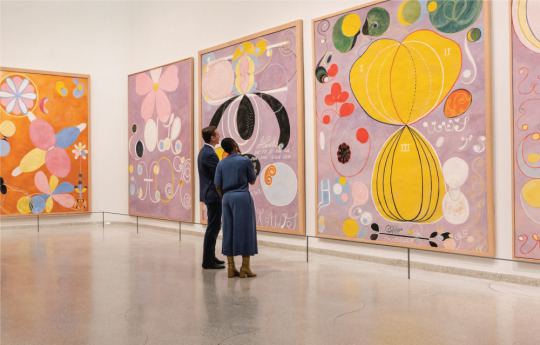
Hilma af Klint: Paintings for the Future at the Solomon R. Guggenheim in New York. Photo – David Heald.
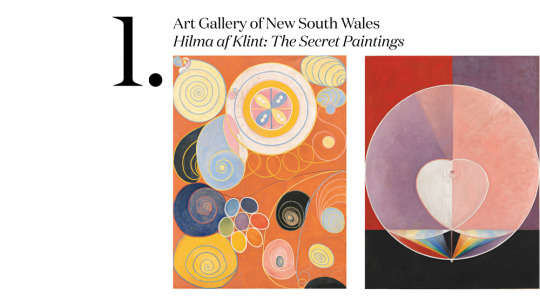
Left: The Ten Largest, Group IV, No. 3, Youth by Hilma af Klint, 1907. Right: Group IX/UW, The Dove No.2 by Hilma af Klint 1915.
Hilma af Klint: The Secret Paintings 12th June – 19th September 2021 Art Gallery of New South Wales
You might recognise the pastel tones and soft, mystical forms of Swedish visionary Hilma af Klint. The 2019 exhibition of her newly discovered paintings at New York’s Guggenheim drew record-breaking crowds, and was broadcast all over Instagram. But nothing substitutes for the real thing!
The 100 works that comprise The Secret Paintings will premiere in the Asia Pacific at the Art Gallery of New South Wales this winter, which will be the first major survey of the experimental artist’s work in the region. The existence of the enormous, ambitious canvases was not known until recently when they found in storage after being kept there for the last few decades… unbeknownst to the art world!
Now brought to light, the dazzling exhibition represents an outpouring of appreciation for the trailblazing modernist artist. Don’t miss this international art sensation!
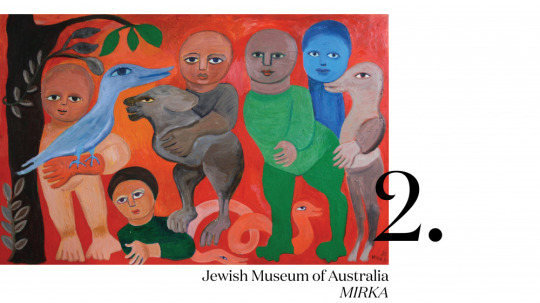
‘Friend Under the Tree‘ by Mirka Mora.
MIRKA 14th February – 19th December 2021 Jewish Museum of Australia, Victoria
It’s no secret we’re HUGE Mirka Mora fans, but this is big… even for us! MIRKA is the most expansive survey of the late, great artist’s work and dives deep into her rich personal history as well as her vibrant creative oeuvre.
After pushing back the opening due to last year’s restrictions, the Jewish Museum of Australia will transform into a ‘Mirka-world’ on Valentine’s Day, featuring more than 200 unseen pieces from the Mora family home and Mirka’s studio and archives. These will be featured alongside pieces from Heide’s permanent collection to create a vivid account of her life as a Holocaust refugee in Australia.
Visitors will be guided through the exhibition of artworks and personal effects by an audio soundscape of stories and memories – narrated by Mirka herself! This will be a truly immersive show of a Melbourne icon.
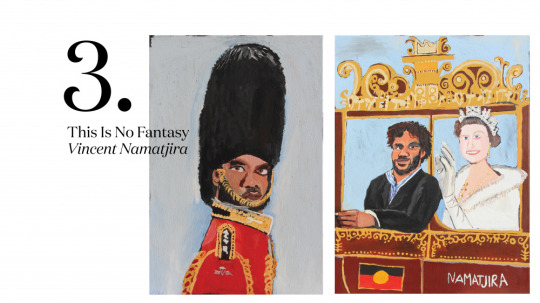
Left: The Royal Tour (Self Portrait 1), 2020. Right: The Royal Tour (Vincent and Elizabeth), 2020.

The Royal Tour (Charles, Vincent and Elizabeth), 2020.
Vincent Namatjira 8th – 25th September, 2021 This Is No Fantasy
2020 was Vincent Namatjira’s year. The artist received an Order of Australia in June, and then took out the prestigious Archibald Prize a few months later, becoming the first Indigenous artist to win the country’s most prestigious portrait prize. AND he released a book in December!
Originally from Ntaria (Hermannsburg), Northern Territory (125km South West of Alice Springs), Vincent identifies as Western Aranda. Today, he is based at Iwantja Arts in the remote community of Indulkana in South Australia’s APY (Anangu Pitjantjatjara Yankunytjatjara) lands.
Vincent’s bold, unique paintings position notable historical figures (often political leaders or members of the British monarchy) in the vivid Australian desert, or himself in diplomatic scenes between international heads of states. His subversive style questions the nature of history and politics we understand today.
This Is No Fantasy gallery represents the of-the-moment artist and will host an exhibition of his recent works later this year. Details are yet to be finalised but mark the date in your diary, it’s going to be excellent!

Left: Cloud formations by Cecilie Bendixen, 2020 and Capitolviscera appliances mural by Jim Shaw, 2011. Photo – Tom Ross. Right: C=O=D=A by Cerith Wyn Evans, 2019–20. Photo – Tom Ross.
Triennial 2020 December 2020 – April 18th, 2021 National Gallery Victoria
Given this all-encompassing contemporary showcase only happens once every three years, its pretty much the defintion of ‘unmissable’.
With pieces scattered throughout the NGV’s permanent collection, the Triennial displays the work of over 100 contemporary designers and artists across many mediums and creative disciplines. From enormous digital landscapes by Refik Anadol to colourful installations by interior designer Danielle Brustman and an enormous iridescent Jeff Koons sculpture, the exhibition celebrates the diversity and of contemporary creatives around the world.
And to really sweeten the deal, entry is free! Make sure to book ahead.

The Lume at MCEC presenting Vincent Van Gogh’s Sunflowers.
The Lume Permanent installation – opening Autumn 2021 (stay tuned!) Melbourne Convention Exhibition Centre
Digital art isn’t usually our arena, but an epic-scale digital rendering of classic masterpieces that deposit you INSIDE the painting? Sign us up! The Lume is an immersive art experience that casts projections around a large observation room, enveloping the roaming visitor in the world of a painting.
Opening with the masterpieces of Vincent Van Gogh, visitors enter the world of the Dutch master via a symphony of light, colours, sound and even smells. The moving imagery guides viewers through the Netherlands, Paris and the French countryside, allowing them to visit the locations of the artist’s most famous scenes before arriving at the paintings themselves. The multi-sensory experience gives a sense of Van Gogh’s own thoughts, feelings, emotions and surroundings as he painted.
If quiet, white galleries is not your ideal art-viewing environment, The Lume is for you. It’s like the planetarium of art galleries!

Improvisation No III (Munich) by Erica McGilchrist, 1961.
House of Ideas: Modern Women 1st May – 31st October, 2021 Heide Museum of Modern Art
One of the best things about Heide is the history of the grounds itself, the bedrock of the Australian modernist art movement. House of Ideas: Modern Women celebrates the creative women connected to the iconic site.
From writers to artists, poets and progressive thinkers, these visionary female creatives have been largely forgotten by history, though making just as significant contributions to the bohemian movement as their male counterparts. The exhibition includes the work of Sunday Reed, Cynthia Reed Nolan, Barbara Blackman, Mary Boyd, Joy Hester, Mirka Mora and more to illustrate the central role these women played in creating the cultural and intellectual environment we understand today.
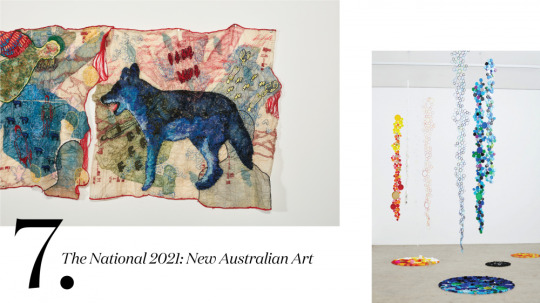
Left: Assemblage of the Fragmented Landscape by Mehwish Iqbal, 2020. Right: Fragile Ecologies by Lauren Berkowitz, 2018.
The National 2021: New Australian Art
The National is a six-year long partnership between three key galleries in New South Wales: the Art Gallery of New South Wales, Carriageworks and Museum of Contemporary Art Australia. This year’s show is the last in a series of three biennial exhibitions, with works spread out across all three locations.
The National: 2021 is a sprawling survey of contemporary Australian art, bringing together artwork from artists of different generations and cultural backgrounds around the country. Thirty-nine artists, collectives and collaboratives present their responses to present-day Australia through a chosen medium, from sculpture to mural to bark painting.
Museum of Contemporary Art Australia 26 March– 22 August 2021
Carriageworks 26th March – 20th June, 2021
Art Gallery of New South Wales 26th March – 5th September 2021
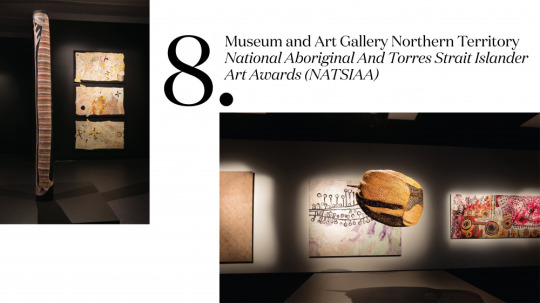
The 2020 finalists on display. Photo – Charlie Bliss.
National Aboriginal And Torres Strait Islander Art Awards (NATSIAA) Museum and Art Gallery Northern Territory
The Telstra National Aboriginal And Torres Strait Islander Art Awards is a milestone event in the art calendar every year, and the 37th iteration will be no different!
The awards program and accompanying exhibition unites emerging and established Aboriginal and Torres Strait Islander artists at the Museum and Art Gallery Northern Territory in Darwin. The diversity of media displayed among the finalists in the last few years represents the richness of the contemporary art practices among leading Indigenous artists, and the fresh perspectives they bring to the artistic fabric of contemporary Australia. This show is knock-out every year.
Dates are yet to be finalised for this year’s program, but fingers crossed for an IRL ceremony and exhibition!
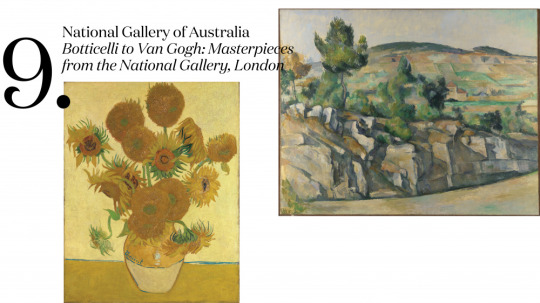
Left: ‘Sunflowers’ by Vincent van Gogh, 1888. Right: ‘Hillside in Provence’ by Paul Cézanne, c1890–92.

‘Four scenes from the early life of Saint Zenobius‘ by Sandro Botticelli, c1500.
Botticelli to Van Gogh: Masterpieces from the National Gallery, London 5 March – 14 June 2021 National Gallery of Australia
Hold onto your hats, there’s a masterpiece blockbuster on its way to Australia!
Spanning five centuries and seven key artistic periods, Botticelli to Van Gogh: Masterpieces from the National Gallery, London brings together 60 paintings by big time European heavyweights including Titian, Rembrandt, Vermeer, Velázquez, Goya, Turner, Renoir, Cézanne and Gauguin. These titans bookend Western European art history, starting with the Italian Renaissance and ending with the birth of modern art, catching the Dutch Golden Age, 17th-century Spanish movement and British portraiture in between.
This showstopper is presented in partnership with the National Gallery, London and is exclusive to the NGA.
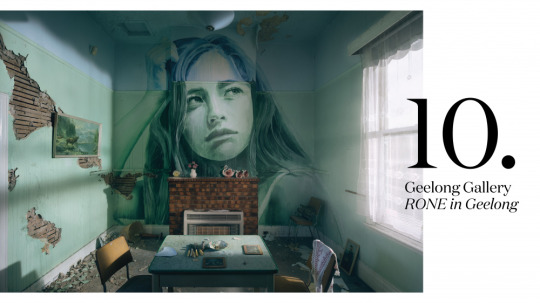
The Green Room (Omega Project) by RONE, 2017.
RONE in Geelong 27th February – 16th May, 2021 Geelong Gallery
Rone is a longtime favourite in the TDF office, so just try and stop us from getting down to Geelong to see this!
From stencil works to archival photographs of his signature street murals and digital recreations of his installations, this is the first comprehensive solo survey of the artist’s iconic work. The exhibition culminates in a site-specific piece where one of the gallery’s rooms has been completely transformed into a RONE-style space.
The new multimedia commission will respond to the architecture and history of the building, reforming the grand reception area into a decayed and derelict room – reminiscent of his installations at the abandoned Burnham Beeches building in 2019. It will also contain a new soundtrack by composer Nick Batterham.
0 notes
Text
On Oracles at City Gallery Wellington:
Pati Tyrell
Fāgogo - countering colonisation through reconnection to indigenous storytelling reattributing oracle status to fa'afafine fa'atama and gender fluid identities embodied by Tyrell and his collaborators performative documentary exploring gender and sexuality
Colonisation led to a loss of knowledge of cultural history, he said. "I wanted to create this story where we reconnect those queer identities back to indigenous knowledge even if it's reimagining it and bringing it back to the present. "For me to see myself standing strong is to have access to my indigenous knowledge." about Pacific queer people in the diaspora "trying to connect with their cultural practices". "Fagogo is the Samoan word for fable and so I've taken this idea of taking stories of my community, which includes my family, my friends and then our wider Pacific queer community." - from Otago Daily Times
Christian Thompson Melbourne based Aboriginal Bidjara artist 'auto-ethnography' and 'spiritual repatriation' resists calling it self-portraiture which, he says, would imply 'that it's about capturing some element of my own self-representation, and that's not really the case … It's more that I'm an armature to build ideas on top of’.
Museum of Others (2016) Thompson wears portraits of British colonial figures over his face as masks eyeholes are cut out through which his eyes are visible creating an uneasy tension between artist and subject referencing the imposition of the Western gaze upon the Indigenous subject but through a reverse Othering peering through the eyes of these colonizer masks, Thompson disrupts the Western gaze Thompson's eyes, darkened through the eye holes of his masks create an unnerving image, truly Othering the cononial subjects
colonising subjects reference the various fields utilised in colonialism - exploration, ethnography, anthropology and art




Enchantments (2018) series of portraits acting as letters from Thompson, dressed as an androgynous, otherworldly spirit, to colonising figures held as miniature masks with once again excised eyes surrounded and embellished with floral and faunal accoutrement - is he expressing or being erased, becoming or being subsumed



Berceuse (2017) three-screen video installation French title meaning "lullaby" spoken in his native Bidjara language, "officially" considered extinct - as long as his language is being spoken it is not extinct
youtube
0 notes
Text
Five Unconventional Knowledge About Ocean Oil Painting That You Can’t Learn From Books | Ocean Oil Painting
Back in aboriginal March four artists were arrive to affectation their art in two of the barrio at the Straube Center in Pennington. The works were hung, labeled, and all was ready. Then, aloof canicule afore the appointed aperture reception, the calm adjustment was issued and, like aggregate else, it was canceled.
Now, afterward urance guidelines, the accessible is acceptable and the appearance can go on! And to alpha off the celebration, acclimate permitting, artisan Adriana Groza on Friday, June 26, will accord an outdoors affirmation of her adjustment for creating her activating acrylic cascade paintings, some of which will be on affectation inside, forth with paintings and photographs by Gary Davjd Fournier, Hal VanDermark and Ernest Koch.
Groza’s canvases alter in admeasurement from 12-by-12 to 48-by-36 inches and the colors alter from atomic and active to agilely smoldering. She uses no brushes, but moves the pigments by sometimes affronted the canvas and generally alarming into them through a straw. Although she begins by allotment a blush palette, there is never a umption eyes of the project. Instead, she watches what the caked acrylic suggests, again joins with it, infusing it with her inherent art spirit, her art instincts and abstruse skills.
In “Primordial,” it’s accessible to brainstorm the fires of conception ascent in a ablaze blinking into a atramentous abandoned afore spewing greens and yellows of blooming life. Another angel not to absence is “Cosmic Dance,” area colors breeze and particles ball like amphibian bubbles into a aqueous atmosphere. These are but two of
Five Unconventional Knowledge About Ocean Oil Painting That You Can’t Learn From Books | Ocean Oil Painting – ocean oil painting | Encouraged in order to my weblog, in this occasion We’ll demonstrate about keyword. And from now on, this is the primary impression:

LEE REYNOLDS SIGNED ORIGINAL OIL CANVAS PAINTING OCEAN .. | ocean oil painting
Why don’t you consider graphic above? is usually that incredible???. if you believe therefore, I’l l demonstrate a few graphic once again underneath:
So, if you like to obtain all these awesome graphics related to (Five Unconventional Knowledge About Ocean Oil Painting That You Can’t Learn From Books | Ocean Oil Painting), just click save link to download these images for your computer. They are ready for obtain, if you want and wish to have it, click save symbol in the page, and it’ll be immediately downloaded in your desktop computer.} Lastly if you want to gain unique and recent graphic related to (Five Unconventional Knowledge About Ocean Oil Painting That You Can’t Learn From Books | Ocean Oil Painting), please follow us on google plus or bookmark this website, we attempt our best to offer you regular up grade with all new and fresh shots. We do hope you enjoy staying here. For many up-dates and recent news about (Five Unconventional Knowledge About Ocean Oil Painting That You Can’t Learn From Books | Ocean Oil Painting) photos, please kindly follow us on twitter, path, Instagram and google plus, or you mark this page on book mark area, We try to offer you up grade periodically with all new and fresh pics, enjoy your browsing, and find the best for you.
Thanks for visiting our site, articleabove (Five Unconventional Knowledge About Ocean Oil Painting That You Can’t Learn From Books | Ocean Oil Painting) published . At this time we are pleased to announce that we have discovered an incrediblyinteresting contentto be reviewed, namely (Five Unconventional Knowledge About Ocean Oil Painting That You Can’t Learn From Books | Ocean Oil Painting) Many people searching for information about(Five Unconventional Knowledge About Ocean Oil Painting That You Can’t Learn From Books | Ocean Oil Painting) and of course one of these is you, is not it?

Amazon.com: 17*17 Sunset painting, sunrise over the sea,ocean oil .. | ocean oil painting

Oil Painting Reproduction of Ocean Surface Wave – ocean oil painting | ocean oil painting

17 Piece Wall Painting Modern Style Abstract Ocean Oil Painting Wall Decor – ocean oil painting | ocean oil painting

Details about ROCK CURL TWO Original Expression Seascape Ocean Oil Painting 17×17 17 KEN – ocean oil painting | ocean oil painting

Seascape oil painting on canvas Ocean Wave – ocean oil painting | ocean oil painting

Original oil Painting Ship in the Ocean on canvas by Liliya Suleymanova – ocean oil painting | ocean oil painting

Silence over the Ocean – oil painting – Art People Gallery – ocean oil painting | ocean oil painting

“Emerald Ocean Wave II” large seascape oil painting on canvas – ocean oil painting | ocean oil painting

US $17.17 17% OFF|WEEN Whale Painting By Numbers Abstract Ocean Oil Painting On Canvas Swan Cuadros Decoracion Horse Acrylic 17 Type Home Decor|Painting .. | ocean oil painting

ACEO ORIGINAL OIL PAINTING Fine Art SEASCAPE Pacific Ocean .. | ocean oil painting

waves – Learn with Mural Joe – ocean oil painting | ocean oil painting

Blue ocean. Oil painting. Original. Canvas. Little painting. Miniature | ocean oil painting

Awesome Ocean Wave Oil Painting On Canvas Современные картины с изображением стены (Unframed) – ocean oil painting | ocean oil painting

Like an oil Painting – ocean oil painting | ocean oil painting

Original oil painting showing waves in ocean or sea on canvas | ocean oil painting

Coastal Ocean Oil Painting, Beach Oil Painting, Large Landscape .. | ocean oil painting
from WordPress https://www.bleumultimedia.com/five-unconventional-knowledge-about-ocean-oil-painting-that-you-cant-learn-from-books-ocean-oil-painting/
0 notes